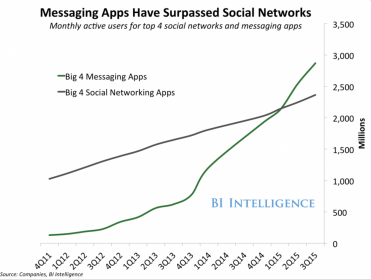How ‘Unbundling’ CX Could Spell The End For The App

A regular contributor to B&T, Graham Christie (Pictured Below), former CEO at Big Mobile and now principal at independent consultancy The Golden Acre, signals an important CX shift well and truly underway…
In Australia and the rest of APAC, digital transformation is being significantly hampered by the persistent reluctance to integrate mobile fully into the Customer strategy, relying on outdated App models, and neglecting the fundamental change in the way people manage their content and brand choices.

One of the main things we’re witnessing as a consequence, is the death of the mobile App, at least as we know it. Outside of activities such as, banking, real estate, and entertainment, it’s undeniable that people think apps are plain difficult to find, only real brand fans bother downloading them anyway, and those that do use sparingly or never a few weeks afterwards.
Consider the chronology of the relationship between mobile and marketing. Starting off with SMS, then moving to a pre iPhone mobile web (yes – this was a thing), the arrival and explosion of smartphone apps and content, social media networks with personal updates shifting with the consumer to mobile, and now messaging apps overtaking those social networks.

The typical brand focused iOS/Android application of recent times has essentially sought to aggregate these elements, and numerous others, in the one ‘super-bundled’ place, but to be hard-nosed, this archetype that populates app stores in such great numbers, few consumers really care about. The next stage is upon us.
Consumers are ‘unbundling’ their usage patterns, selecting platforms and technologies to meet their specific needs and are looking to control them far more actively. They are accepting of an SMS from their bank, and email from their energy provider, a push notification from a fashion retailer, messages from their friends, and news headlines they want to see, all delivered to their mobile’s home screen. They prioritise when and how often, and are as happy to delete, as they are to set up. People are increasingly looking for a ‘quick check-in’ to the things that matter to them. For instance, in a report by eDigital Research, a USbank recorded an SMS open rate of 60 per cent with a click-to-open rate of 37.5 per cent.
Mobile usage increased 13 percent, and retention rates increased an estimated 5 percent. Engagement most marketing channels would love. In a separate piece in Forrester’s “Five Mobile Myths From A Millennial’s Perspective,” a survey revealed that 57 per cent of that segment were likely to take action after receiving a notification from a retailer for instance. The Report cautions marketers however to ensure any messaging strategy has at it’s foundation, relevancy. Well of course, but I would add that this relevancy needs to work harder than the intelligence leveraged in ad targeting given the sanctity of the home screen.
In life, some of the best conversations are short ones, certainly they can be the most effective. So adapting CX strategy to integrate this element means working harder on at least four key elements such as; what you know about them (who they are and their usage behaviours), what they need (what utility you are to them), when and where they might like to hear from you (recency), and effectiveness (analytics and evaluation). Achieve this and you’re more likely to get interaction on those notifications, which means the customer essentially qualifies themselves, before you take them elsewhere to continue to sell or service.
There are clears signs this ‘unbundling’ is happening at the big end of town. Google has been testing click-to-message through Adwords that connects (via SMS) advertisers directly with consumers. This as a response to Facebook’s Messenger upgrades that really talk more to customer journeys, not advertising per se.
However, the legacy of most marketing departments organisationally and the agency ecosystem, is that both promote separation not unification, hence why there is so much angst around ‘transformation’ and the collision of adtech with martech. The table stake of any approach is that the CEO must enthusiastically sponsor it, the process be ruled by the CMO, and it has to start and end with the consumer with technology being the agile enabler.
In summary, it was simple when all we needed to do was keep going with search, desktop and traditional media, and then build a fancy App, but this is very far from the case today. The behavioural changes taking place highlight the rather inconvenient reality that marketers and their agencies need to work harder to ‘unbundle’ the consumer experience to be able to engage productively rather than just exhibit noise. Using data to understand the role of messaging, (in it’s very broadest sense), in the day to day lives of the mobile consumer, and developing an all-inclusive strategy is actually where the heavy lifting and consequentially the great customer advocacy rewards in digital marketing lie. It’s not simply Social, and it’s not the super-shiny new thing getting pitched to you.
Latest News

TV Ratings (18/04/2024): I’m A Celebrity Wins Prime Time And Key Demos
Aussie viewers can be a harsh lot at times. Only days after Ellie Cole bled her heart out, she has been sent packing.

Effie&co Launches New ConnectAsia Division To Help Aussie Brands Market To Asian Consumers Overseas & At Home
Not provided is advice on using chopsticks and not spilling ramen down your shirt.

Cashrewards Sets Out Stall For New CMO
Thinking of applying for the Cashrewards CMO gig? Here are some insider tips that, yes, are tantamount to cheating.

‘I Ask For The TV Industry To Stand Up And Defend Itself’ – Seven Boss James Warburton Steps Down
The Seven supremo heads for the exits after five years. Here's hoping the Spotlight team organised the farewell bash.

Poh! Jamie! Adriano! Paramount ANZ reveals its tasty plans for this year’s MasterChef
It's your fan's guide to this year's MasterChef! Although no tips on how to pronounce crudités or use a un fait-tout.

Dentsu’s iProspect Partners With MOOD Tea Ahead Of May Campaign Launch
We love a Mood Tea here at B&T. Although we do store old screws and nails in the International Roast caterer's tin.

Opinion: When Culture Starts Eating Itself: Navigating The Age Of Self-eating Nostalgia
Born boss David Coupland asks is adland going through a nostalgia period? But please, no repeats of Best Of Red Faces.

Who’s Going To Cannes?! The TikTok Young Lions Winners!
It's Aussie adland's next gen! They're off to Cannes with high hopes of bringing back a Lion & a foot-long Toblerone.

Adobe Launches Express Mobile App With Firefly AI
Want to be the coolest kid at Friday staff drinks but forgot your retro Nikes? This new Adobe wizardry may do the trick.

ThinkNewsBrands & IMAA Extend News Publishing Education In Brisbane
Industry duo takes its publishing roadshow to Brisbane. Was disappointed no male attendees were wearing walk socks.

B&T Chats With Wavemaker’s Provocative Pioneers On Their Cross-Pacific Sojourn
B&T TV heads to Wavemaker's Sydney digs to interview two staffers from its New York & LA digs. If that makes sense?

HoMie & Champion Launch “Give One. Get One” Campaign Supporting Youth Homelessness Via Town Square
Much like the fête's prized chutney wears a blue winners sash, so too should this top initiative from HoMie & Champion.

Thinkerbell Takes Us Back To Summer In Latest Work For XXXX
This beer ad wants to take you back to summer! Just minus any chance of a shark attack on your morning bus commute.

Cannes Lions Unveils 2024 Programme Featuring Queen Latifah, Jay Shetty & P&G’s Mark Pritchard
Are you one of the lucky ducks heading to Cannes in June? Check out the headliner acts you'll be queueing hours to see.

Scroll Media Recruits Costa Panagos From Twitch
Costa Panagos set to bring South American flair to the Scroll offices. Assuming that he is, indeed, South American.

Year13, Microsoft & KPMG Australia Launch AI Course For Gen Zs
Born around the 2000s? Need to amp up your AI creds? This guide's for you (although it's not really that age specific).

General Motors Snares Heath Walker From Scania
Do you rage about oversized American cars on our roads? You need to bail up Heath Walker at parties & industry events.

VML Launches New “Envoyage” Brand For Flight Centre
VML unveils new brand for travel operator Flight Centre. Alas, no sign of those paid actors pretending to be pilots.

Subaru Places Media Account Up For Review
Subaru puts media up for review, as adland journos get set for mandatory "agency drives off with..." headline.

TV Ratings (17/04/2024): Contestants Faced With Harsh Realities As Alone Australia Heats Up (Or Cools Down)
Alone still doing the business for SBS. Overly long train journeys not doing the business, but they persist anyway.

Ben Fordham Loses Number One Spot As Ray Hadley Celebrates 156th Ratings Win
The radio numbers are in! Discover who's off for a boozy lunch today & who's waiting for the dreaded HR death knock.

Gourmet Ice Cream Brand Connoisseur Launches New “Thrill Your Senses” Iteration, Via SICKDOGWOLFMAN
Rattling the old "truth in advertising" adage comes this ice-cream spot full of noticeably thin people.

Paramount’s Global Sales Boss: ‘Australia’s Converged Model Is A Blueprint For How I’d Like All Of Our Markets To Be’
Paramount's global sales boss gives local sales ops the thumbs up. Didn't weigh-in on the Lisa Wilkinson debacle.

TikTok Starts Testing Its Instagram Rival In Australia
In exciting news for piano playing cats & brattish pranks in shopping centres, TikTok unveils its Insta rival plans.

Man Wrongly Named By Seven As Bondi Killer Hires Lawyers
Struggling to save for a house deposit? Why not get wrongly identified by Sunrise!

Smartsheet Appoints Indie Agency Sandbox Media To Its Media Account
Can't stand your colleagues? Like to dob them in when they miss a deadline? These work management platforms are ideal.

Boss Not Letting You Come To Cannes In Cairns? Use This Business Case To Convince Them!
Stingy boss won't spring for a ticket to Cairns? Add this to your persuasive argument repertoire. Or grovel.

Alt/shift/ Brisbane Builds Portfolio With Ausbuild Creative, PR, Content & Social Account Win
The Brisbane comms/PR agency lands constructor Ausbuild. Also hoping for a discount on its new glass conservatory.

Young Guns Versus The Old Guard: Who Adds More Value to Our Industry?
Cannes In Cairns poking this hornet's nest in a lively debate. Just so long as the oldies can get up the stairs.

70% Of Aussies Don’t Have Green Power Plans ENGIE Says In Major Brand Campaign Via HERO
Are you the notorious "light leaver on-er" in your flatshare? Quell any infighting with this green energy news.

PrettyGood Launches Offering Brand & Media Solutions For Australasian SMEs
B&T applauds the charitable nature of this new agency. Although we'd hate to see it impact any Chrissie present sends.

A Blunt End: Dolphins Medicinal Cannabis Sponsorship At Risk
Yes, it's another NRL drug story. Yet, thankfully it doesn't involve coke in Kuta during the off-season.

Slew Of New Creative Hires At Leo Burnett Australia
Ahhh, all black! The outfit of choice for agency creatives, David Jones staff and everyone in Melbourne.

Under Armour Unveils Local “Live in UA” Campaign
American apparel brand set for yet another tilt at the Aussie market, as Nike declares "we'll see about that".

Pepsi Launches New Look, Refreshing Classic Fashion Staples Via Special PR
Are you always the bridesmaid, never the bride, as the old saying goes? How do you think Pepsi feels?

Pure Blonde Returns To A Place Purer Than Yours In New Campaign Via The Monkeys
B&T's always been a huge fan of the 'drink yourself thinner' diet plan. So big thanks to Pure blonde, vodka & tequila.
